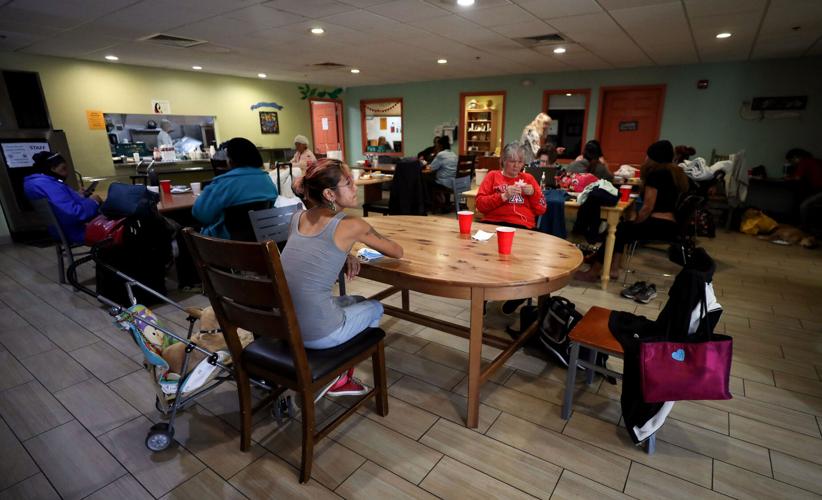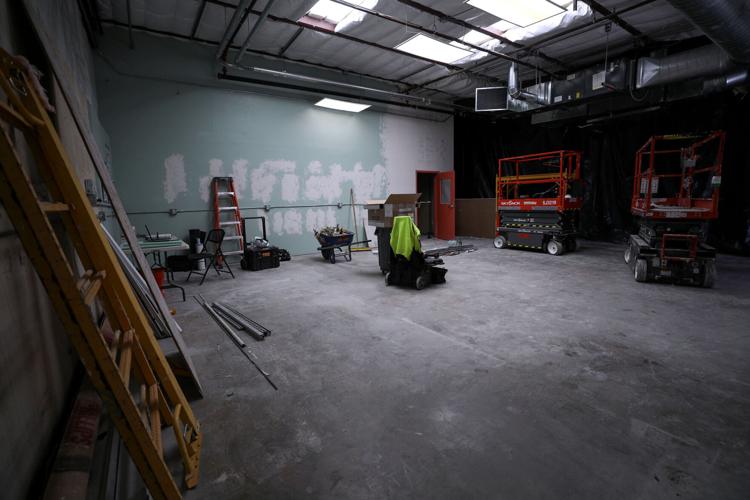With an 11th-hour infusion of federal funds on the way, leaders of Pima County’s migrant-aid coalition are optimistic they will be able to avoid the predicted releases of migrants onto Tucson’s streets when existing federal support runs out on April 1.
While the plan is still uncertain, local leaders were hopeful late Monday afternoon that sufficient funds would arrive in time to extend Pima County’s migrant-aid coalition’s efforts for another three months.
“It sounds like everyone is confident we’re going to have the federal funds to avert street releases, and the layoffs of staff across Casa Alitas,” said Diego Piña Lopez, director for Casa Alitas, the Tucson migrant-aid program of the nonprofit Catholic Community Services.
Casa Alitas had already told 30 staff members that their last day would be March 31, and informed 10 more that they’d lose their positions mid-April, due to the loss of federal funding.
On Friday, Congress approved a $1.2 trillion U.S. spending package, allocating $650 million to the federal Shelter and Service Program, which supports local communities’ migrant-aid efforts.
That’s a nearly 20% decrease from the prior year’s funding level. But compared to the complete funding loss that was expected on April 1, it’s a game-changer for local officials who had been bracing for a dramatic reduction in services for legally processed migrants released here by the Border Patrol.
Tucson and Pima County leaders spent Monday in a flurry of meetings, trying to determine whether they can maintain services for newly arrived migrants seamlessly, or if bureaucratic delays would mean the new funding would arrive too late to avoid street releases of unsheltered migrants next week.
“There are two questions: how much, and when?” said Pima County spokesman Mark Evans early on Monday. “Everything is in flux right now.”
In recent days, border agents have been releasing fewer migrants to Casa Alitas, Evans said.
Casa Alitas received about 500 legally processed migrants each day over the weekend, Evans said. That’s about half the volume the program has been seeing in recent weeks, and less than a third of the volume of a few months ago.
Migrant arrivals at the southern border have slowed since reaching record levels in December, but Tucson has remained the busiest of the southern border’s nine sectors since July.
In February, border agents in the Tucson sector apprehended 49,452 people between ports of entry, compared with more than 80,000 in December, according to the latest figures from U.S. Customs and Border Protection. Since the start of the fiscal year in October, through February, Tucson sector border agents have apprehended 300,000 people between ports of entry.
The $1.2 trillion U.S. spending package continues to prioritize border enforcement — with $19.6 billion going to CBP, a 19% increase — while other critical areas are cut, said Colleen Putzel-Kavanaugh, associate policy analyst for the nonpartisan Migration Policy Institute.
Legislators also recently reduced the funding appropriation for U.S. immigration courts under the Executive Office for Immigration Review, from $860 million last year to $844 million, at a time when immigration courts are facing a backlog of 3 million cases.
Too-few asylum court officers means asylum seekers released by the Border Patrol can face years-long waits for their asylum hearings, migrant advocates say.
“What we’re seeing is this continued mismatch in funding, where Border Patrol gets a lot of funding ... but that similar funding increases aren’t seen across the entire immigration system,” Putzel-Kavanaugh said. “That mismatch creates a lot of the problems downstream that we continue to see today.”
SSP funding, reduced from $800,000 last year, will probably be insufficient for the need, Putzel-Kavanaugh said.
“It creates a smaller pot of money, when more and more groups are actually going to try to access that funding,” she said. “It’s going to create either a scenario where some organizations don’t receive funding at all, or many organizations receive far less funding then they’d need to keep operations at the level they’ve been.”
Piña Lopez said he stayed up late Friday night to see if the funding bill would pass both chambers of Congress.
“It’s exciting, but also stressful,” he said on Monday.
The anticipated loss of federal funds on April 1 meant that partnerships with vendors and other contractors — such as ties to food vendors, local hotels, security and janitorial services — were set to be paused or canceled. Getting those partnerships back up and running could take some work, but Casa Alitas is well-practiced at adjusting on a dime, he said.
“All of those relationships play a vital role in our operations,” Piña Lopez said. “That’s the thing we’ve always done a good job of; we can pivot and adjust based on whoever we see coming to our shelter. … It’s us working as a team.”
Impact on homelessness
Pima County’s migrant-aid coalition has aided more than 400,000 legally processed migrants since 2019, after they’ve been released from Border Patrol custody with a notice-to-appear in court.
Thousands of travelers have passed through Tucson on their way to their final destinations, with little to no noticeable impact for most Tucson residents, thanks to Casa Alitas’ work, local officials say.
Migrants typically stay just one or two nights at Casa Alitas — getting a shower, medical care, charging their cell phones and utilizing the WiFi to purchase plane tickets — before joining family or sponsors in the interior of the country. About 97% of migrant arrivals at Casa Alitas pay for their own travel from Tucson.
Last year, the program spent $1.6 million in federal funding to buy plane tickets for 2.4 percent of its migrant arrivals, totaling 5,300 flights, according to a February county memo.
When federal funding for the $1 million-per-week migrant-aid effort wasn’t renewed by last month, Casa Alitas and its Pima County partners began making plans to scale back services to a level that could be sustained on donations alone, anticipating serving just 100 people per day.
That reduction was expected to result in up to 400 migrants each day released without any supports in downtown Tucson, and 500 more released in rural border communities each day.
In late February, Pima County Administrator Jan Lesher warned of “homelessness on steroids“ if more federal funding didn’t come through.
Local homeless shelters are already overburdened, and are usually set up to serve specific populations, such as people struggling with substance abuse or mental health issues. Integrating migrants, particularly families with children, who mostly only need a helping hand in getting to their final destinations, is not what those providers are geared towards, agency leaders say.
Sister José Women’s Shelter in Tucson, which serves single women experiencing homelessness, is already sheltering one migrant woman from the Congo, as she waits for her asylum hearing in September, said Nicola Hartmann, the shelter’s CEO. The woman entered the U.S. between ports of entry near Lukeville in December, and doesn’t have any relations in the U.S., so she had nowhere to go to wait for her hearing, Hartmann said.
Sister José has recently seen a significant increase in the number of women it serves, who are increasingly older women struggling with rising housing costs in Tucson, she said.
“Like the rest of the city, we’ve seen huge increases,” Hartmann said. “We want to help (migrants), we’re just concerned about what that volume could look like. ... Most nights we’re at capacity anyway. We can always do a bit more with food and some clothing, but we’re concerned about what that will mean for us, and the community.”
Arizona Sens. Kyrsten Sinema and Mark Kelly have been pressuring their colleagues to approve $752 million in SSP funding, “to avoid a catastrophic situation,” they wrote to legislators in late February.
“Replenishing these funds has been a critical need for Arizona border communities,” Kelly said in a Saturday news release after announcing the $650 million secured in SSP funds. “That’s why Senator Sinema and I urged congressional leaders to not leave our border communities behind and fought hard to include this and other resources in the final government funding bill. While I believe there is more the federal government must do, this assistance will help local governments and nonprofits in Arizona bearing the cost of the crisis.”
Gov. Katie Hobbs also wrote to Congress in support of Kelly and Sinema’s request. Her office said last week they expect to continue with state-funded transportation of migrants released in smaller border communities, such as Douglas and Nogales, to bigger cities like Tucson and Phoenix.
“Gov. Hobbs has provided tens of millions of dollars to local governments struggling with the increase in migration,” Hobbs’ spokesman Christian Slater wrote in a Thursday email. “She will continue with her current work to meet the needs of our border communities to keep the border secure while making sure they have the capacity needed to deal with the influx of asylum seekers and other migrants in a safe, secure and humane way.”
Arizona’s Department of Emergency and Military Affairs, or DEMA, coordinates those state-sponsored buses from rural border communities, where even fewer resources for migrants exist.
DEMA has transported more than 38,000 legally processed asylum seekers, via 840 buses, since January, DEMA spokeswoman Judy Kioski said. In 2023, the state spent more than $7 million in state Border Security Fund resources on those transportation services.
“The state-sponsored bus mission will continue to provide bus transportation while funding exists,” an agency statement said. “DEMA will only transport legally processed asylum seekers at the request of local jurisdictions to an NGO that has the capacity to support them with temporary sheltering and onward travel arrangements.”
Get your morning recap of today's local news and read the full stories here: tucne.ws/morning







